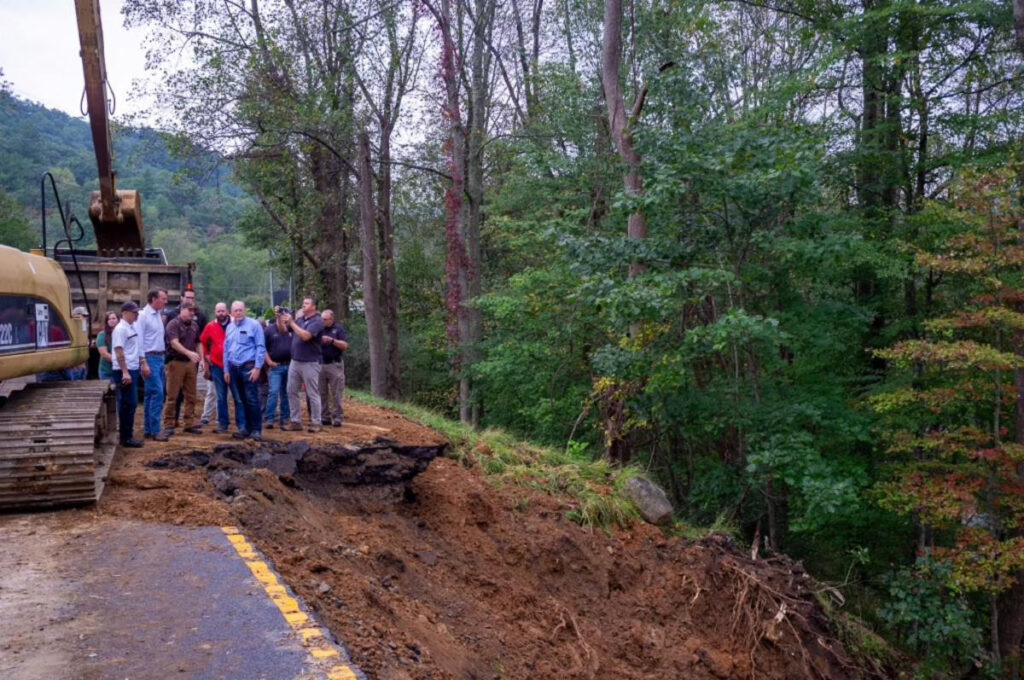Gov. Glenn Youngkin, in blue jeans, assesses storm damage caused by Hurricane Helene in Grayson County on Sept. 29, 2024. (Courtesy of Christian Martinez, Office of Governor Glenn Youngkin)
Restoration efforts in Southwest Virginia continue after Hurricane Helene’s deadly impact, as Republican Gov. Glenn Youngkin asserted that blaming the intense storm and the future unpredictability of weather on climate change was a distraction.
While giving an update on damage assessments from the storm that made landfall in Florida last week and dumped several inches of rain, with two confirmed tornados, in the mountainous regions of Virginia, Youngkin urged people to call 1-800-621-3362, go to FEMA.gov or use a FEMA app download to seek help and start documenting the application process for federal recovery funding.
“Also, there are regional centers that are being established by FEMA and (partner)with the Virginia Department of Emergency Management in the area,” Youngkin said, adding people are going door-to-door to help people fill out forms as part of the Major Disaster Declaration the state received.
“This is a really important process,” Youngkin said. “Many people don’t know how to fill out these forms. Getting them the help that they need is critically important.”
During the update from federal, state and local officials at the Virginia Department of Emergency Management Emergency Operations Center in North Chesterfield Friday morning, VDEM spokesman John Elmore reported that 519 homes had been counted as damaged so far, with 44 destroyed, and 475 damaged or affected. The total number of impacted businesses, ranging from small ones to large manufacturers, had climbed to 83.
These counts, which don’t include damages to local government buildings, are expected to go up.
Two people died in the immediate wake of the storm, and Youngkin said that everybody has been accounted for.
About 13,700 people are still without power in the region, Youngkin said, after about 96% of outages had been restored. Crews are using helicopters to deliver telephone poles to the hard to reach areas that remain. Out of the 287 cell-phone service towers that were knocked out, 14 still needed to be fixed, the governor added.
Furthermore, 28 water systems are under a boil advisory, and Youngkin urged everyone in the region to flush systems and seek replacement pumps, particularly for well users that comprise a vast majority of residents in the area.
Schools in “many counties” remained closed Friday, while others were having delays, Youngkin said. Waivers have been requested by the federal government so meal services for disadvantaged families could be extended to all school children. About 40,000 meals had been given out, in addition to grassroots efforts, as a medical reserve corps of professionals from other regions in the states have trekked to the impacted area to help with medication, oxygen tanks and wheelchairs that “have been just washed away.”
Two primary roads remain impassible, and 52 secondary rods are closed, and U.S. Route 58 has about a 1.5 mile stretch that is “absolutely impossible,” Youngkin added.
“This is going to be a long restoration rebuild process, but I am confident that if we can just keep focus, and not allow the standard ‘it’s been two weeks now and we’re moving on to the next issue’ to settle in, because I will not allow that to happen,” Youngkin said, adding that Southwest Virginia will rebuild “stronger than it was before.”
Republican Gov. Glenn Youngkin speaks to the staff at the Virginia Department of Emergency Management. (Charlie Paullin/Virginia Mercury)
While taking questions from reporters, Youngkin declined to share his thoughts about climate change’s influence when a Virginia Mercury reporter asked about it.
“Nobody get distracted by that question,” said Youngkin, who in 2022 acknowledged climate change was a “threat” in an interview about his energy plan, which called for a re-evaluation of the state’s Virginia Clean Economy Act. The landmark 2020 VCEA seeks to decarbonize the grid by mid-century to halt human-caused climate change.
“We are right now in a moment of providing people a pathway back to hope,” Youngkin continued, before talking about the gratitude he received for his visits, including an afternoon visit by U.S. Sen. JD Vance, R-Ohio, the Republican vice presidential nominee, on Thursday.
“Yesterday, when Senator Vance was there and everyone was saying ‘thank you for coming,’ this is a region of Virginia and America that has historically been forgotten,” Youngkin said. “I just have no time for folks who are trying to politicize this moment.”
FEMA administrator Deanne Criswell said on the CBS news program Face the Nation on Sunday that “In the past, when we would look at damage from hurricanes, it was primarily wind damage, with some water damage.”
“But now we’re seeing so much more water damage, and I think that is a result of the warm waters, which is a result of climate change,” Criswell said.
After FEMA had denied relief requests from residents in the region in 2022 and 2021, the state dipped into $830 million in revenues from a carbon-market that requires electricity producers to purchase allowances for carbon emissions as another attempt to halt climate change.
The state directed $29 million of the funds, which were initially intended to increase flood protections and make homes energy efficient, to provide relief to residents. Youngkin pulled Virginia out of the market — the Regional Greenhouse Gas Initiative — calling it a “hidden tax,” since utilities can recover the costs of allowances from ratepayers.
Legislators used a budget amendment to appropriate any unused funds, which amounted to about $40 million at the start of the year, according to a report by Radio IQ. A special session would be needed to pass a similar budget amendment or legislation to support the region ahead of the regular session scheduled to start in January.
“I’ve got to assess what we need,” Youngkin said when asked if he would call one.
GET THE MORNING HEADLINES.

